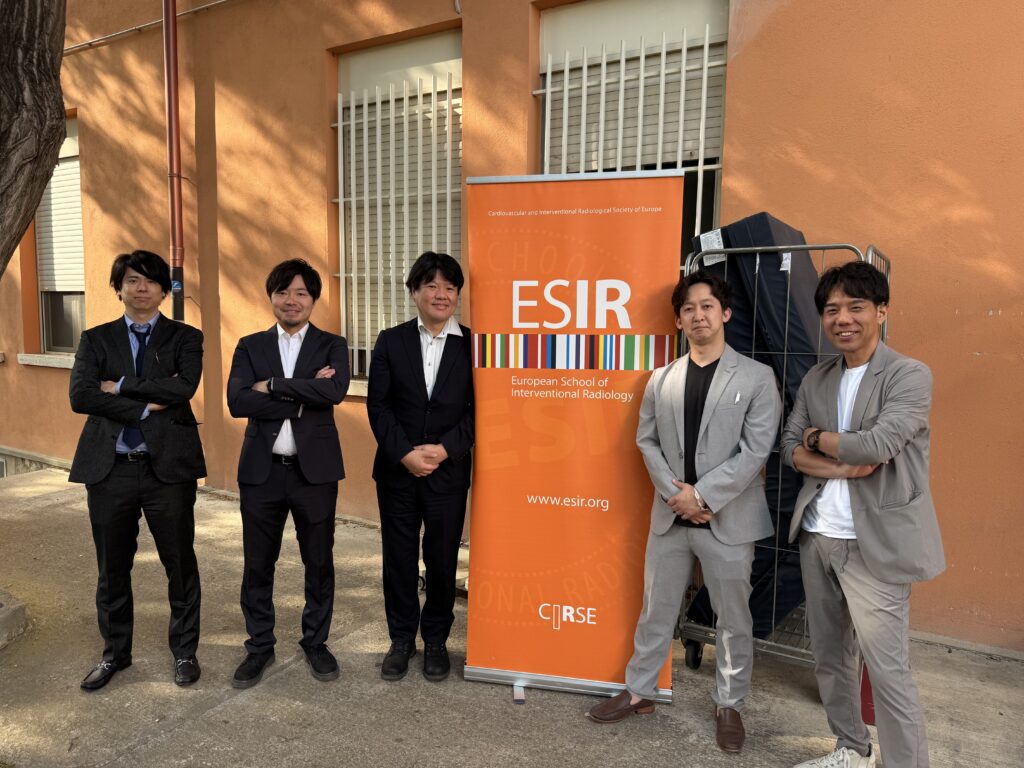
Our doctors and staff were able to visit Italy recently for a training session!
In Europe, unlike Japan, the trend is not for open surgery, but for minimally invasive treatments. Doctors in the EU have an incentive to not perform surgery, as surgery is often very taxing on the bodies of the elderly, costly, and caries many risks. In the EU, Interventional Radiologists are at the forefront of this non-surgical movement.
During the ESIR 2025 Cagilari Conference, many doctors from all over Europe gave presentations, as well as many attending doctors from all over the world, from countries like the US, New Zealand, France, Austria, Denmark, the UK, Italy, Spain, the UAE, and others.
The main topic of the conference was about various interventions available for the lumbar area that are both minimally invasive and effective for the lumbar region. What was surprising to the doctors visiting from Japan was that the treatments being introduced at the conference were the ones already being used at ILC, mainly Lobster, Q-Fusion, and Discogel.
The presenters gave overviews of the indications for each type of treatment, how to choose the patients correctly, and how to effectively complete each treatment. For each treatment, the doctor with the most experience in the field gave a detailed presentation. We were able to learn that techniques like Lobster and Qfusion are just normal, every day treatments here, with some doctors performing 4-6 interventions in a day. Since the treatments are easily done and the doctors have a lot of experience, patients feel at ease receiving the treatment.
Interspinous Process Spacers are a major topic for Interventional Radiologists because they bridge the gap between conservative treatment (like medicine, rehab) and open surgery. In countries like Japan, Interventional Radiologists are rare, for multiple reasons. One is that both the pharmaceutical companies and surgeons are very powerful. It feels like there is only one option if conservative treatment doesn’t work, and that option is always surgery.
In the past, brain and heart surgeries requiring lengthy hospital stays and carrying huge risks for the patients were incredibly common in Japan. In the 1980s and 1990s, advances in minimally invasive interventions came about in the form of fluoroscopy and catheters. At first, surgeons in Japan were hesitant to use these treatments, as only 30% of heart surgeries were performed via catheter in the 1990s, but that number has grown to around 84% in 2020.
At the ESIR conference, it was clear to us that the minimally invasive option is a much better, much clearer option for patients who clearly need help but cannot have surgery for any number of reasons. For example, Dr. Marcia (IR, Cagliari, Italy) told a story of a patient who was refused surgery. This patient, who was elderly, was saved by the interventional radiologist. This type of patient is abundant in Japan, but the existence of spacers is new. Many times, a patient would be turned down for surgery and told to just live with the pain. In our opinion, this is no way to live a life, so as such, we came looking for answers.
There are many interspinous process spacers available on the market, but presenter after presenter would mention the Lobster and QFusion spacers as their tools of choice. The ease of use, the time required, and the lack of a hospital stay make them attractive options.
The more we listened, it became clear that it would be easier for the doctors to be able to see the signs and indications at ILC. The presenting doctors gave detailed indications for the various lumbar illnesses, such as spinal canal stenosis, spondylosis, lumbar disc herniation, bulging discs and more. With the tools on display, they showed via video cases about how easy it was to perform, how safe it was for the patients, and how quickly it can be done.
One of the best things about these interspinous process spacers is how many extra people can be saved from chronic back pain in a short amount of time. Japanese people are suffering from so much back pain that it is considered a national illness. However, in Europe, patients are much less tolerant of pain and seek out non-surgical methods of pain relief. Thus, there are many doctors all over the EU that calmly and safely perform these minimally invasive treatments, often combining multiple treatments at the same time to increase the efficiency. Patients will routinely receive ozone treatment along with the interspinous process spacers or Discogel. The ozone will work as an anti-inflammatory and disinfectant, both increasing the efficacy of the treatments and leading to an even better outcome.
Ozone, in particular, is frequently used in Italy, where it was first discovered to have medicinal properties. Thanks to this, it is safely used for all sorts of applications, not limited to lumbar interventions, such as intravenously to improve blood flow, improve the function of white blood cells, treat inflammation in the shoulders, knees and other joints, plus a myriad of other techniques.
Discogel was mentioned several times during the training as something that can be used alone and in conjunction with other treatments, due to its excellent prognosis for patients suffering from disc herniations, degenerative disc disease, bulging discs and other disc related illnesses. In fact, presenter Dr. Filippiadis (Interventional Radiologist, Greece) referenced a dozen research papers highlighting the efficacy of Discogel, with several mentioning how it can be just effective as endoscopic surgery on the disc. It also shows a longer lasting effect than conservative surgery.
After the lectures, our doctors were able to participate in many hands-on workshops, where they were able to learn new techniques from the presenting doctors. Even our experienced doctors were able to see a fresh viewpoint on the treatments they already perform in Japan. The makers of the interspinous process spacers were also on hand to explain the details of their treatments. It was a valuable experience for the doctors from Japan, as they were able to ask various questions on how each device worked in detail, see how they were made, and ask for advice for various patients and situations that they have experienced in their daily practice.
Overall, the training was a great success, as the doctors from ILC were able to gain even more confidence that the treatments they are already performing in Japan are the right choice for patients looking to avoid traditional surgery but want something more than conservative treatment. ILC is at the forefront of this under-filled gap in Japan, in collaboration with doctors from all over the world, looking to treat 100% of back pain symptoms with a combination of various cutting edge technologies and total body wellness, to make Japan a better, pain-free country with a long-life expectancy.
-1024x768.jpeg)



